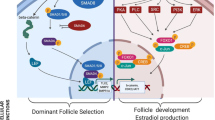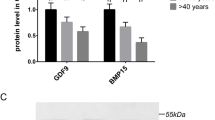Abstract
Unexpected poor ovarian response (UPOR) occurs when nine or fewer oocytes are retrieved from a young patient with normal ovarian reserve. Bone morphogenetic protein15 (BMP15) and growth differentiation factor 9 (GDF9) are two oocyte-specific factors with pivotal role in folliculogenesis. The aim of this study was to assess the relation between BMP15 and GDF9 variants with UPOR. Hundred women aged ≤ 39 with AMH ≥ 1.27 IU/ml participated as UPOR and normal ovarian responders (NOR) based on their oocyte number. Each group consisted of 50 patients. After genomic DNA extraction, the entire exonic regions of BMP15 and GDF9 were amplified and examined by direct sequencing. Western blotting was performed to determine the expression levels of BMP15 and GDF9 in follicular fluid. Additionally, in silico analysis was applied to predict the effect of discovered mutations. From four novel variants of BMP15 and GDF9 genes, silent mutations (c.744 T > C) and (c.99G > A) occurred in both groups, whereas missense variants: c.967-968insA and c.296A > G were found exclusively in UPORs. The latter variants caused reduction in protein expression. Moreover, the mutant allele (T) in a GDF9 polymorphism (C447T) found to be more in NOR individuals (58% NOR vs. 37% UPOR (OR = 2.3, CI 1.32–4.11, p = 0.004).
The novel missense mutations which were predicted as damaging, along with other mutations that happened in UPORs might result in ovarian resistance to stimulation. The mutant allele (T) in C447T polymorphism has a protective effect. It can be concluded that there is an association between BMP15 and GDF9 variants and follicular development and ovarian response.



Similar content being viewed by others
Data Availability
The data that support the findings of this study are available from the corresponding author on request.
References
Ferraretti AP, La Marca A, Fauser BCJM, Tarlatzis B, Nargund G, Gianaroli L. ESHRE consensus on the definition of ‛poor response to ovarian stimulation for in vitro fertilization: the Bologna criteria. Hum Reprod. 2011;26(7):1616–24.
Sunkara SK, Rittenberg V, Raine-Fenning N, Bhattacharya S, Zamora J, Coomarasamy A. Association between the number of eggs and live birth in IVF treatment: an analysis of 400 135 treatment cycles. Hum Reprod. 2011;26(7):1768–74.
Hendriks DJ, Te Velde ER, Looman CWN, Bancsi LFJMM, Broekmans FJM. Expected poor ovarian response in predicting cumulative pregnancy rates: a powerful tool. Reprod Biomed Online. 2008;17(5):727–36.
Reynolds KA, Rhee JS, Jimenez PT, Omurtag KR, Tuuli MG, Jungheim ES. Reply: Poor ovarian responders: to meta-analyse or not, that is the question. Hum Reprod. 2014;29(3):635–6.
Younis JS, Ben-Ami M, Ben-Shlomo I. The Bologna criteria for poor ovarian response: a contemporary critical appraisal. J Ovarian Res. 2015;8:76. https://doi.org/10.1186/s13048-015-0204-9.
Alviggi C, et al. A new more detailed stratification of low responders to ovarian stimulation: from a poor ovarian response to a low prognosis concept. Fertil Steril. 2016;105(6):1452–3.
Humaidan P, Alviggi C, Fischer R, Esteves SC. The novel POSEIDON stratification of ‘Low prognosis patients in Assisted Reproductive Technology’ and its proposed marker of successful outcome. F1000Res. 2016;5:2911. https://doi.org/10.12688/f1000research.10382.1.
Alviggi C, et al. Clinical relevance of genetic variants of gonadotrophins and their receptors in controlled ovarian stimulation: a systematic review and meta-analysis. Hum Reprod Update. 2018;24(5):599–614.
Drakopoulos P, et al. Conventional ovarian stimulation and single embryo transfer for IVF/ICSI. How many oocytes do we need to maximize cumulative live birth rates after utilization of all fresh and frozen embryos? Hum Reprod. 2016;31(2):370–6.
Van Tilborg TC, et al. Individualized versus standard FSH dosing in women starting IVF/ICSI: an RCT. Part 1: The predicted poor responder. Hum Reprod. 2017;32(12):2496–505.
Liu MN, Zhang K, Xu TM. The role of BMP15 and GDF9 in the pathogenesis of primary ovarian insufficiency. Hum Fertil. 2021;24(5):325–32.
Morón FJ, et al. Bone morphogenetic protein 15 (BMP15) alleles predict over-response to recombinant follicle stimulation hormone and iatrogenic ovarian hyperstimulation syndrome (OHSS). Pharmacogenet Genomics. 2006;16(7):485–95.
De Castro FC, Cruz MHC, Leal CLV. Role of Growth differentiation factor 9 and bone morphogenetic protein 15 in ovarian function and their importance in mammalian female fertility - a review. Asian-Australasian J Anim Sci. 2016;29(8):1065–74.
Sanfins A, Rodrigues P, Albertini DF. GDF-9 and BMP-15 direct the follicle symphony. J Assist Reprod Genet. 2018;35(10):1741–50.
Mottershead DG, et al. Characterization of recombinant human growth differentiation factor-9 signaling in ovarian granulosa cells. Mol Cell Endocrinol. 2008;283(1–2):58–67.
Paulini F, Melo EO. The role of oocyte-secreted factors GDF9 and BMP15 in follicular development and oogenesis. Reprod Domest Anim. 2011;46(2):354–61.
Peng J, et al. Growth differentiation factor 9:bone morphogenetic protein 15 heterodimers are potent regulators of ovarian functions. Proc Natl Acad Sci U S A. 2013;110:8.
Mottershead DG, et al. Cumulin, an oocyte-secreted heterodimer of the transforming growth factor-β family, is a potent activator of granulosa cells and improves oocyte quality. J Biol Chem. 2015;290(39):24007–20.
Gilchrist RB, Lane M, Thompson JG. Oocyte-secreted factors: regulators of cumulus cell function and oocyte quality. Hum Reprod Update. 2008;14(2):159–77.
Sugimura S, Ritter LJ, Sutton-McDowall ML, Mottershead DG, Thompson JG, Gilchrist RB. Amphiregulin co-operates with bone morphogenetic protein 15 to increase bovine oocyte developmental competence: effects on gap junction-mediated metabolite supply. Mol Hum Reprod. 2014;20(6):499–513.
Laissue P, et al. Mutations and sequence variants in GDF9 and BMP15 in patients with premature ovarian failure. Eur J Endocrinol. 2006;154(5):739–44.
Otsuka F, McTavish KJ, Shimasaki S. Integral role of GDF-9 and BMP-15 in ovarian function. Mol Reprod Dev. 2011;78(1):9–21.
Dong J, Albertini DF, Nishimori K, Kumar TR, Lu N, Matzuk MM. Growth differentiation factor-9 is required during early ovarian folliculogenesis. Nature. 1996;383(6600):531–5.
Kumar R, Alwani M, Kosta S, Kaur R, Agarwal S. BMP15 and GDF9 gene mutations in premature ovarian failure. J Reprod Infertil. 2017;18(1):185–9.
Jaillard S, et al. New insights into the genetic basis of premature ovarian insufficiency: novel causative variants and candidate genes revealed by genomic sequencing. Maturitas. 2020;141:9–19.
França MM, et al. Identification of the first homozygous 1-bp deletion in GDF9 gene leading to primary ovarian insufficiency by using targeted massively parallel sequencing. Clin Genet. 2018;93(2):408–11.
Di Pasquale E, Beck-Peccoz P, Persani L. Hypergonadotropic ovarian failure associated with an inherited mutation of human bone morphogenetic protein-15 (BMP15) gene. Am J Hum Genet. 2004;75:106–11.
Tiotiu D, Mercadal B, Imbert R. Variants of the BMP15 gene in a cohort of patients with premature ovarian failure. Hum Reprod. 2010;25:1581–7.
Wu YT, Wang TT, Chen XJ, et al. Bone morphogenetic protein-15 in follicle fluid combined with age may differentiate between successful and unsuccessful poor ovarian responders. Reprod Biol Endocrinol. 2012;10:116. https://doi.org/10.1186/1477-7827-10-116.
Wu YT, et al. High bone morphogenetic protein-15 level in follicular fluid is associated with high quality oocyte and subsequent embryonic development. Hum Reprod. 2007;22(6):1526–31.
Van Royen E, et al. Characterization of a top quality embryo, a step towards single-embryo transfer. Hum Reprod. 1999;14(9):2345–9.
Takebayashi K, Takakura K, Wang H, Kimura F, Kasahara K, Noda Y. Mutation analysis of the growth differentiation factor-9 and -9B genes in patients with premature ovarian failure and polycystic ovary syndrome. Fertil Steril. 2000;74(5):976–9.
Liu J, et al. Mutational analysis of human bone morphogenetic protein 15 in Chinese women with polycystic ovary syndrome. Metabolism. 2011;60(11):1511–4.
Ma L, et al. Single nucleotide polymorphisms in premature ovarian failure-associated genes in a Chinese Hui population. Mol Med Rep. 2015;12(2):2529–38.
Adzhubei I, Jordan DM, Sunyaev SR. Predicting functional effect of human missense mutations using PolyPhen-2. Curr Protoc Hum Genet. 2013;76:7.20.1-7.20.41. https://doi.org/10.1002/0471142905.hg0720s76.
Duffy DM. Growth differentiation factor-9 is expressed by the primate follicle throughout the periovulatory interval. Biol Reprod. 2003;69(2):725–32.
Dixit H, et al. Mutational screening of the coding region of growth differentiation factor 9 gene in Indian women with ovarian failure. Menopause. 2005;12(6):749–54.
Chand A, Ponnampalam A, Harris S, Winship I, Shelling A. Mutational analysis of BMP15 and GDF9 as candidate genes for premature ovarian failure. Fertil Steril. 2006;86(4):1009–12.
Bilibio JP, Meireles AJ, De Conto E, Lorenzzoni PL, do Nascimento FC, da Cunha-Filho JS. GDF9 polymorphisms: influence on ovarian response in women undergoing controlled ovarian hyperstimulation. J Bras Reprod Assist. 2020;24(4):447–53.
Hanevik HI, Hilmarsen HT, Skjelbred CF, Tanbo T, Kahn JA. A single nucleotide polymorphism in BMP15 is associated with high response to ovarian stimulation. Reprod Biomed Online. 2011;23(1):97–104.
Zhuang J, Li H, Li X, Tian D, Yang D, Zhu M. The incidence of unexpected poor ovarian response in Chinese young women. Med. (Baltimore). 2019;98(7):e14379.
Liu L, et al. Infertility caused by retardation of follicular development in mice with oocyte-specific expression of Foxo3a. Development. 2007;134(1):199–209.
Patino LC, et al. BMP15 mutations associated with primary ovarian insufficiency reduce expression, activity, or synergy with gdf9. J Clin Endocrinol Metab. 2017;102(3):1009–19.
Dixit H, et al. Missense mutations in the BMP15 gene are associated with ovarian failure. Hum Genet. 2006;119(4):408–15.
Vanyan R, Dolgushina N, Donnikov A. Single nucleotide polymorphisms of BMP15 are associated with poor ovarian response in in vitro fertilization programs. JFIV Reprod Med Genet. 2015;3(4):1–4.
Di Pasquale E, et al. Identification of new variants of human BMP15 gene in a large cohort of women with premature ovarian failure. J Clin Endocrinol Metab. 2006;91:1976–9.
Author information
Authors and Affiliations
Corresponding author
Ethics declarations
Conflict of Interest
The authors declare that they have no conflict of interest.
Additional information
Publisher's Note
Springer Nature remains neutral with regard to jurisdictional claims in published maps and institutional affiliations.
Rights and permissions
Springer Nature or its licensor (e.g. a society or other partner) holds exclusive rights to this article under a publishing agreement with the author(s) or other rightsholder(s); author self-archiving of the accepted manuscript version of this article is solely governed by the terms of such publishing agreement and applicable law.
About this article
Cite this article
Mehdizadeh, A., Soleimani, M., Amjadi, F. et al. Implication of Novel BMP15 and GDF9 Variants in Unexpected Poor Ovarian Response. Reprod. Sci. 31, 840–850 (2024). https://doi.org/10.1007/s43032-023-01370-1
Received:
Accepted:
Published:
Issue Date:
DOI: https://doi.org/10.1007/s43032-023-01370-1




